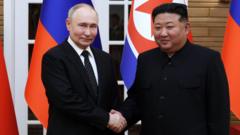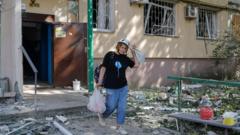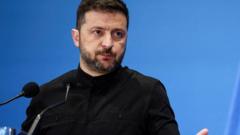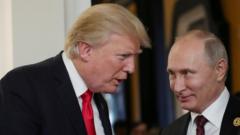The Kremlin's crackdown elevates the stakes in the battle for information, leading to innovative user-driven alternatives.
**Kremlin's War on YouTube: Russians Innovate Despite Censorship**

**Kremlin's War on YouTube: Russians Innovate Despite Censorship**
As internet access tightens, Russians turn to creative solutions to access YouTube amid government throttling.
The tension between the Kremlin and YouTube deepens as Russian authorities intensify their censorship efforts, further restricting access to the platform that has traditionally offered a wide range of content to millions of users. For years, YouTube has served as a vital channel for everything from nostalgic Soviet films to critical political commentary. However, with President Vladimir V. Putin tightening the grip on free speech, YouTube has become the last major Western platform still operational in Russia, provoking the ire of officials.
Although Putin hasn’t issued a formal ban against the platform—with its extensive 2.5 billion global users—Russian authorities are increasingly frustrated by the unfiltered access it provides to anti-government sentiments. The authorities have resented YouTube for removing certain state-sponsored channels and censoring videos by Russian artists affected by Western sanctions.
Last summer marked a turning point when Russian users experienced drastic reductions in service quality, particularly affecting desktop access. Experts suggest that this steep decline in connectivity points to a deliberate throttling orchestrated by the Russian government. The disruptions soon spread to mobile networks as well, resulting in pixelated and slow-loading videos for millions trying to connect.
"This sudden massive drop is 100 percent artificial," stated Philipp Dietrich, an analyst from the German Council on Foreign Relations. The exact mechanisms of interference remain undisclosed, but it is clear that user experience is being adversely affected by state action.
Despite these challenges, Russians are showing resilience and resourcefulness, employing various workarounds to continue accessing YouTube, highlighting the ongoing fight for information in an increasingly restrictive digital landscape.
Although Putin hasn’t issued a formal ban against the platform—with its extensive 2.5 billion global users—Russian authorities are increasingly frustrated by the unfiltered access it provides to anti-government sentiments. The authorities have resented YouTube for removing certain state-sponsored channels and censoring videos by Russian artists affected by Western sanctions.
Last summer marked a turning point when Russian users experienced drastic reductions in service quality, particularly affecting desktop access. Experts suggest that this steep decline in connectivity points to a deliberate throttling orchestrated by the Russian government. The disruptions soon spread to mobile networks as well, resulting in pixelated and slow-loading videos for millions trying to connect.
"This sudden massive drop is 100 percent artificial," stated Philipp Dietrich, an analyst from the German Council on Foreign Relations. The exact mechanisms of interference remain undisclosed, but it is clear that user experience is being adversely affected by state action.
Despite these challenges, Russians are showing resilience and resourcefulness, employing various workarounds to continue accessing YouTube, highlighting the ongoing fight for information in an increasingly restrictive digital landscape.


















